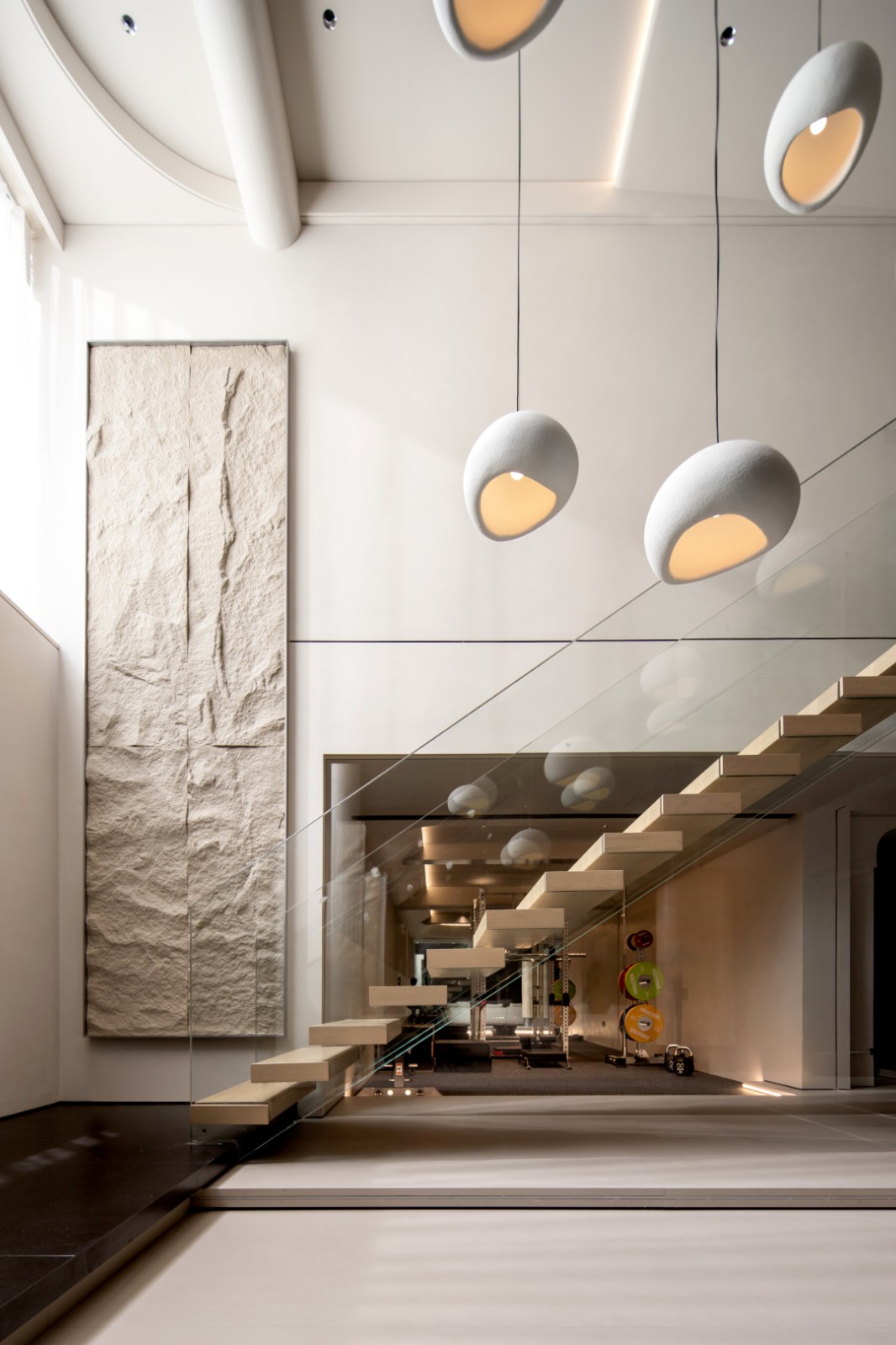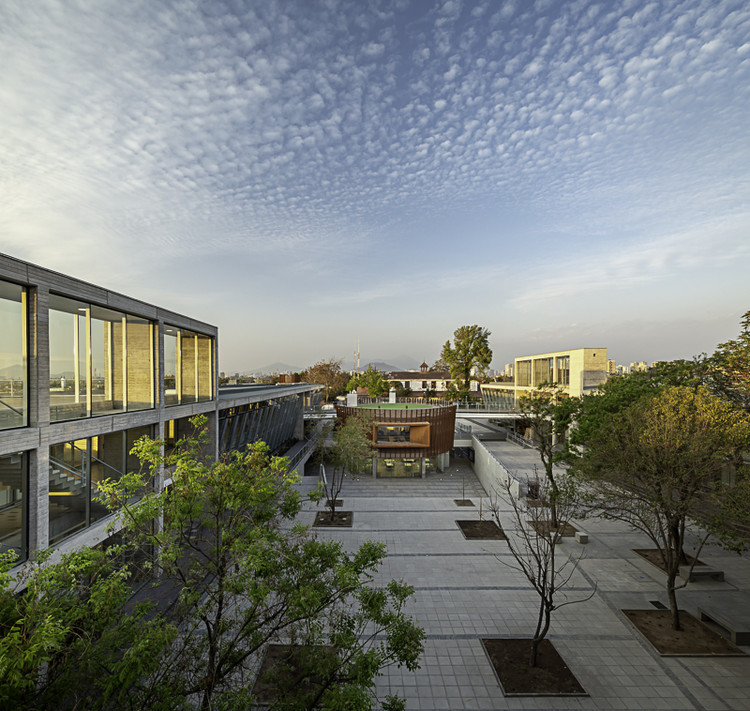Cultural Center of Beicheng Central Park in Hefei Shenzhen Huahui Design
2017-09-22 22:00
一个好的建筑,诞生在一个地方,创造一个地方;人类的经验构成了这个地方的灵魂。
A good building, born on a site and create a place; and the human experience constitutes the soul of the place.
我们试图在建筑与外层空间之间建立一种新的关系,从而创造一种新的场所体验。让我们暂时把这个关联称为“模糊边界”。
We try to create a new relationship between building and its outer space, thus creating a new place experience. Let's call this association "ambiguous boundary" for the moment.
Children’s Playground. Image © Yao Li, Sui Sicong
该项目是近100万平方米中央公园住宅区文化教育设施的一部分。该基地为长方形场地,东西宽约260米,南北宽约70米,南面为城市公园,占地近4万平方米,命名为中央公园项目。
The project is part of cultural and educational facilities for the nearly 1 million square meters Central Park residential area. The base is a rectangular field about 260 meters wide in east and west and about 70 meters wide in north and south, with the city park on the south which covers an area of nearly 40 thousand square meters, after which the Central Park project is named.
Southeast Aerial View. Image © Yao Li, Sui Sicong
在开阔的土地上描绘繁华的景象,几乎是一个大型项目展厅的共同使命。在像这个项目这样的地方,设计的挑战一方面是如何形成一个独特而强大的城市界面,与巨大的城市公园相对应,并共同创造一个可视化的展示。另一方面,它是如何创造一个独特的经验领域,从而激发人们的探索和参与的意愿。借鉴该项目未来的文化教育功能,我们可以先赋予其开放性和文化性,然后推导出这一功能,并对其进行叙事组织。
Depicting the bustling vision in the open land is almost a common mission for the exhibition hall of a large projects. In places like this project, the challenge for design, on one hand, is how to form a distinctive and powerful city interface to correspond with the huge city park, and jointly create a visual display. On the other hand, it is how to create a field of unique experience, so as to stimulate people's willingness to explore and participate. Benefiting from the future cultural and educational function of the project, we can first endow it with open and cultural characteristics, and then deduce the function and organize the narrative on this tone.
Wall-corridor. Image © Yao Li, Sui Sicong
回顾中国传统建筑和古典园林,庭院是最强大的空间形式之一。它几乎构成了中国传统建筑空间的核心特征。庭院的建筑界面是墙和走廊。两者也给庭院带来了不同的空间特征:封闭或渗透,封闭或开放,前者主要存在于街道墙壁和大厦中,后者在园林和庭院中更为常见。而两者往往是结合使用的,使庭院空间具有更好的多样性和故事感染力。
Reviewing the traditional Chinese building and classic garden, courtyard is one of the most powerful spatial forms. It almost forms the core feature of Chinese traditional architectural space. And the building interface of the courtyard is the wall and corridor. The two also bring the courtyard different spatial characteristics: Enclosure or penetration,closed or open.The former is mostly found in street walls and mansions, and the latter is more common in gardens and courtyard. And the two are often used in combination, so that the courtyard space has a better diversity and story appeal.
Wall-corridor with Morning sunshine and long shadow. Image © Yao Li, Sui Sicong
墙-早晨阳光和长长的阴影的走廊。形像:姚丽,隋思聪
当我们试图为庭院空间的定义创造一个新的建筑原型时,我们终于找到了墙和走廊的结合-它只是由短墙组成的走廊,不同的形式和模块的结合,形成了庭院空间的多样性定义,也构成了一个多地体验。这就是我们所说的“模糊边界”。它的形式是自由的,从墙壁的建筑,打算融化在室外的地方。“墙廊”具有统一的整体尺度,-6米高,4米宽,定义了整个场地的边界,同时创造了一个特殊的“圈景域”。当边界有厚度、日常生活和艺术活动时,就有了空间载体,它可以成为孩子放学后玩捉迷藏的天堂,也可以是社区的文化艺术画廊。
While we try to create a new architectural prototype for the definition of the courtyard space, we finally find the combination between the wall and the corridor -- it is just the corridor composed of short wall, with the combination of different forms and modules, forming the diversity definition for courtyard space, also constituting a multiple place experience. This is what we call the "ambiguous boundary". Its form is free from the wall of the building, intended to melt in the outdoor place. "Wall corridor" has a unified whole scale, --6 meters high, 4 meters wide, which defines the boundaries of the entire site, while creating a special "circle scene domain". When the boundary has thickness , daily life and art activities then have a space vector, it can be a paradise for kids to play hide and seek after school and can also be a culture and art gallery of the community.
Basic unit and combination
墙廊围绕着中央水庭,其主体是一个浅水池。作为中国传统园林,水构成了另一个界面,创造了一种放大的建筑规模和空间场感,也模糊了建筑的空间边界,而建筑物对面的人们可以通过一条“新月之路”,从外面穿过水面进入建筑物。而一楼高程不断变化的“新月径”,由于视高的变化,使得交叉过程产生了不同的视觉体验。
The wall corridor encloses the central water court, and its main body is a shallow pool. As Chinese traditional garden, water constitutes another interface to create an amplified architecture scale and space field sense, and also fuzzy the space boundaries, and the people on the other side of the building across the water can, through a "crescent path", go across the water to enter the building from the outside. And the "crescent path" with continuously changing elevation of the ground floor makes the process of crossing produce different visual experiences due to the change of the sight height.
Wall-corridor. Image © Yao Li, Sui Sicong
当人们穿过“新月路”,推开屋檐下的门时,他们首先来到由一堵风景墙构成的大厅,在大厅的北面有一个小展厅,这是一个过渡到中央大厅的空间,而中央大厅是一个更大的规模的展厅,两层高,自然光通过天窗进入空间,经屋顶板过滤后形成多盏灯,最后落在墙上,一天内就可以改变方向和厚度,就像日晷记录时间的流逝一样。背景是二楼的螺旋楼梯和桥梁,横跨中内,连接两个不同的空间,让一楼和二楼的人们可以在这里进行交流和对话。
When people cross the "crescent path ", and push the door open under the eaves, they first come to the hall defined by a piece of scenery wall, in the north of the hall is a small exhibition room, which is a transition space into the central nave, and the central nave is a larger scale exhibition hall, two-storey high, with natural light coming into the space through the skylight, and after being filtered by the roof plate it is shaped into a plurality of lights, finally falling on the wall, in a day, it can change in different directions and thickness, like a sundial recording the passing of time. The background is a spiral staircase and bridges on the second floor which crosses the central nave, connecting two different space, so that people on the first floor and second floor can make exchanges and dialogue here.
the exhibition hall. Image © Yao Li, Sui Sicong
Roof skylights and changes in light and shade
由屋面龙骨和混凝土肋梁形成的天窗构件,通过开缝设计,在中午形成两条不同厚度的射线,构件截面的方向和组合可以在上午提供更大的入射角,下午提供较小的入射角,从而阻挡了大部分西方的曝光。
The skylight components formed by the roof keel and concrete ribbed beam, thanks to the open joint design, form two rays of different thickness at noon, and the direction and combination of the component section can provide a greater incident angle in the morning and a smaller incident angle in the afternoon, thereby blocking out most western exposure.
the entrance hall. Image © Yao Li, Sui Sicong
东侧和南侧作为边厅,提供水吧、谈判和阅读等功能,是通过与室外庭院的连接,特别是在南方的灰色空间,作为儿童游乐场的延续和渗透,进一步增强了儿童游乐场关系的延续和渗透。在两个边厅的外墙上,我们适当地扩展了墙柱的设计语言。在整个空间中,我们不是强调轴心和仪式感,而是用过渡和深度来表现空间的流动性。二楼和三楼由不同大小的教室组成,教室布置在两层高的庭院周围。庭院不仅是一个户外活动空间,而且为教室带来了更好的通风和自然照明。
As the side hall, the east side and south side provide water bar, negotiation and reading and other functions, and is the continuity and penetration of indoor and outdoor space by connecting with the outer courtyard, especially the gray space in the south, as the Children's playground, further enhancing the continuation relationship. On the exterior wall of the two side halls, we appropriately extend the design language of the wall column. In the whole space, we do not emphasize the axis and the sense of ceremony, but use the transition and depth to show the mobility of space. The second and third floors are made up of classrooms of different sizes, and the classrooms are arranged around the two-floor-high courtyard. The courtyard serves not only as an outdoor activity space, but also brings better ventilation and natural lighting for the classrooms.
Ambiguity of the wall-corridor space
在材料选择上,根据建筑形式和功能明确划分,一楼采用混凝土,二楼和三楼采用U型玻璃,将轻、重、虚、实有机地结合在一起。混凝土表面光滑、简单、坚固,特殊的墙体走廊形成稳定开放的界面;U型漫反射玻璃质地湿润,被制成主空间包裹表面,具有“半透明体积感”。两者不会形成强烈的对比,但能产生丰富的温度,并在不同的灯光下表达。
In the choice of materials, we make clear division according to the building form and function, with concrete for the first floor and U type glass for the second floor and third floor, integrating the light and the heavy, the virtual and the real into an organic whole. The concrete surface is smooth, simple and solid, and the special wall corridor form a stable and open interface; and the U type glass of diffuse reflection is moist in texture, which is made into the wrapping surface for main space, displaying a "semi-transparent volume sense". The two will not form a strong contrast, but can generate rich temperature and expression in different lights.
Entrance. Image © Yao Li, Sui Sicong
 举报
举报
别默默的看了,快登录帮我评论一下吧!:)
注册
登录
更多评论
相关文章
-

描边风设计中,最容易犯的8种问题分析
2018年走过了四分之一,LOGO设计趋势也清晰了LOGO设计
-

描边风设计中,最容易犯的8种问题分析
2018年走过了四分之一,LOGO设计趋势也清晰了LOGO设计
-

描边风设计中,最容易犯的8种问题分析
2018年走过了四分之一,LOGO设计趋势也清晰了LOGO设计


















































































































